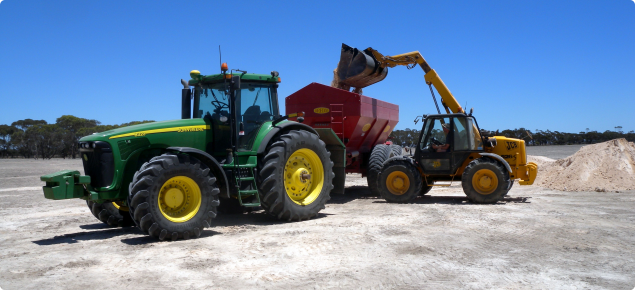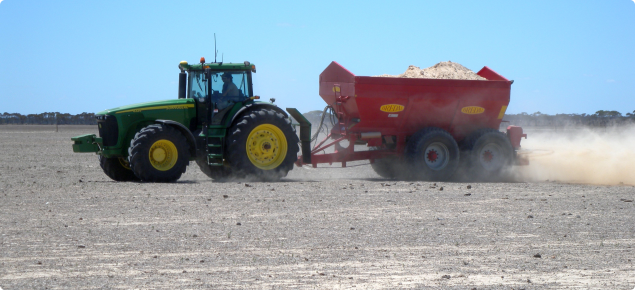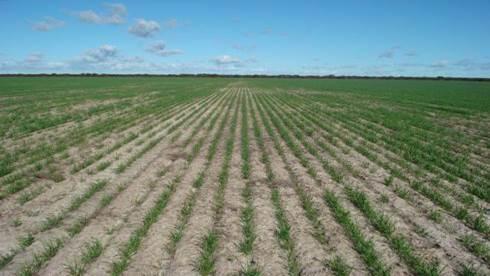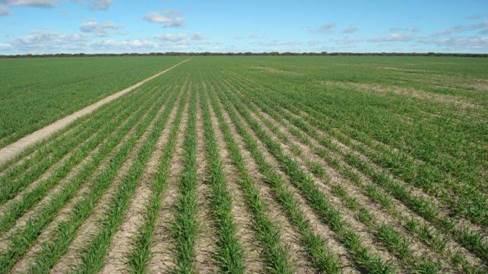The problem with dispersive (sodic) soils
Dispersive soils have several constraints to plant growth:
- low porosity with dense (massive) structure and high soil strength when dry, which prevents root extension
- poor movement of air into subsoils, resulting in low oxygen availability to growing plants
- slow water infiltration, resulting in waterlogging or perched watertables, which drowns roots
- usually neutral to strongly alkaline, and often contain toxic concentrations of boron and salt which restrict root growth and plant-water availability.
Not all sodic soils are a problem, but many are
More than two-thirds of soils within the Western Australian grainbelt are classified as sodic, and many of these soils are duplex with the subsoil clays often being moderately to highly saline and may also contain boron at depth.
There are 3 ways of identifying dispersive (sodic) soils:
- measure the exchangeable sodium percentage (ESP)
- use a simple soil dispersion test
- observe visual indicators of moderate or severely dispersive topsoils.
Not all sodic soils have dispersive behaviour and other soil constraints may be more limiting. Saline-sodic clays are less dispersive than non-saline-sodic soils and have higher infiltration rates. Many sodic clays may still produce wheat yields near their rainfall-limited yield potential, where the salt levels in the soil solution are higher than the critical flocculation concentration but are not yet toxic to plants.
Sodic soils that are a problem:
- Sodic soils with dispersive topsoil and subsoil. These usually produce low crop yields. The alkaline loamy duplexes (calcic grey sodosol) – also known as moort or salmon gum soils – often have very low water-use efficiencies (<10 kilograms per hectare of yield per millimetre of growing season rainfall) due to dispersive and dense topsoils, even though their deep subsoil is not as limiting.
- Generally, soils with a clay content greater than 30%, ESP greater than 6, and salinity levels of ECe of less than 200 millisiemens per metre (mS/m) are prone to dispersion.
- Sodic soils with dispersive-clay topsoil, and are sodic, saline and boron toxic in the subsoil. About one-third of sodic soils in the grainbelt of Western Australia fit this category. Potential-yield models based on seasonal rainfall can estimate productivity within dryland farming systems. We recommend applying one or more management options (see below) where soils produce less than 70% of their rainfall-limited yield potential.
Management options
The intent of these management options is to improve soil structure and prevent the problems experienced on these soils. The options are:
- Destock paddocks when the soil is wet; pugging by livestock feet damages surface soil structure and increases surface sealing.
- Avoid disturbing already productive sodic soils.
- Apply agricultural lime or gypsum.
- Increase organic matter content.
- Use deep-ripping in conjunction with slotting or trenching with added gypsum.
- Use raised beds or deepened seedbeds.
- Use plants more tolerant of waterlogging and sodicity, or change land use.
Avoid disturbing already productive sodic soils
In WA, sodic subsoils will generally maintain their structure if left undisturbed. Assess past productivity first and sodicity second. If productivity has been good, keep managing them the same way.
Apply lime or gypsum
In the right conditions, adding lime or gypsum to dispersive soils decreases the sodium exchange percentage, reduces dispersion, and increases stable soil structure. Calcium ions displace some of the sodium ions on the surface of soil particles, creating better soil structure which allows sodium ions to leach out.
Adding lime
Lime should only be applied to acid soils (where pH in calcium chloride is less than 4.8) because lime will not dissolve in alkaline soils and will have no benefit. Some sodic soils in the high rainfall areas can be acid.
Adding gypsum
Gypsum can be applied on the surface of alkaline soils. Gypsum improves the structural stability of dispersive topsoils quite quickly. Figures 1 and 2 show the crop difference in the same year of gypsum application. The quickest and most effective way to treat sodic subsoil is to add gypsum directly to the subsoil, using deep cultivation, slotting or trenching.
Surface applications of gypsum may be less beneficial in deep sandy or loamy duplex soils where the dispersive clay subsoil is deeper than 40cm, because most crop roots are in the upper 40 cm of the soil profile. Table 1 provides a guide on the rate (tonnes per hectare, t/ha) of gypsum application for different degrees of dispersion (sodicity), exchangeable sodium percentage and pH of the soil.
| Dispersive behaviour or sodicity rating1 | Exchangeable sodium percentage (ESP %) | Gypsum application rate on neutral to acid soils (t/ha)2 | Gypsum application rate on alkaline soils (t/ha)2 |
|---|---|---|---|
| Slight | 6–10 | 0–1.5 | 1.0–2.5 |
| Moderate | 10–15 | 2.5 | 5.0 |
| Severe | >15 | 5.0 | 5.03 |
1 The requirement for gypsum is best determined by assessing the dispersive behaviour of the soil and not just the ESP. See Identifying dispersive (sodic) soils for more information.
2 Rates adapted from Rengasamy, P, North, S & Smith, A 2010, Diagnosis and management of sodicity and salinity in soil and water in the Murray Irrigation region, The University of Adelaide, South Australia, viewed 26 May 2017 http://www.dpi.nsw.gov.au/__data/assets/pdf_file/0003/445944/Diagnosis-of-Sodicity-and-Salinity-in-soils-and-water-in-the-Murray-Irrigation-region_North.pdf
3 Experiments on the south coast of WA indicate that, while soil condition improves noticeably, rates of gypsum application above 5 t/ha do not result in additional yield increases during the first 5 years. We have no observations in subsequent years. Higher rates of gypsum are best applied over a series of seasons.
Increase organic matter
Organic matter binds soil aggregates together and helps resist physical breakdown of soil. This in turn makes it easier for sodium to leach out. Organic matter is best applied in conjunction with gypsum or lime.
Options to increase soil organic matter include:
- stubble retention
- green and brown manuring
- phase-cropping with a deep-rooted perennial pasture, such as lucerne.
Use deep-ripping
Deep-ripping can be used to break up compacted and poorly structured soils and to help generate structure and porosity. However, the benefits can be very short-lived. Sometimes deep-ripping makes the soil worse because worked (tilled) soil disperses more readily and the area will become too boggy.
Ripping can bring up large clods of dispersive soil and bring toxic elements, such as boron and salt, to the surface. We recommend subsoil testing before ripping, or deep-ripping on a small test strip.
After ripping, apply lime (in acid soils) or gypsum, preferably with additional organic matter, to help stabilise the deep-ripped soil. A tramline (controlled traffic) farming system will help prevent re-compaction of the loosened soil.
Use raised beds or deepened seedbeds
Both of these practices involve the lifting and aeration of hardsetting topsoils or soils prone to waterlogging. This improves soil drainage and structure. Where the topsoil is structurally unstable, add gypsum and organic matter to maintain the improved structure. Raised beds rely on drainage channels.
Use alternative plant and land-use options
- Choose crop or pasture plants with higher sodicity and waterlogging tolerance.
- Change the land use if soil amelioration is not practically or economically feasible. Options might include revegetation; perennial pastures, possibly in phase rotation with crops; or commercial tree-planting.
Some crops are more tolerant of sodicity and waterlogging than others:
- Wheat is moderately tolerant and can produce good yields at ESP values of 30% under suitable conditions.
- Lentil and chickpea yields are severely restricted by ESP values of 10%.
- Grain legumes have varying waterlogging tolerance (as indicated by root and shoot growth): faba bean (most tolerant), yellow lupin, grass pea, narrow-leafed lupin, chickpea, lentil, then field pea (least tolerant).
Plants with a strong root system can create root pathways in sodic subsoils, and these pathways can be used by subsequent crops. Lucerne is known to root deeply into sodic soils in WA. Wheat following lucerne on sodic soils has been measured to extract water from deeper in the soil than an adjacent wheat crop grown after an annual legume pasture.
The economic viability of soil amelioration and the combination of management options you can apply will depend on the soil type, the extent, severity and location of the dispersive soil in the profile, as well as the presence of salt and toxic concentrations of boron. If salt levels are high, the soil should be managed primarily as a saline site because the high salt levels will prevent dispersion (Table 2).
| Salinity rating | Electrical conductivity (ECe) (mS/m) | Electrical conductivity (EC1:5) ESP <6% | Sodicity rating (non-sodic) ESP 6–15% | Sodicity rating (sodic) ESP 6–15% | Sodicity rating (strongly sodic) ESP >15% |
|---|---|---|---|---|---|
| Non-saline | <200 | Sand <15 Loam <20 Clay <25 | Grow crops and pastures suitable to soil and climatic conditions | Apply gypsum. Minimise soil compaction. Implement controlled traffic. Increase organic matter. Consider planting waterlogging-tolerant crop and pasture species. | Apply gypsum. Minimise soil compaction. Implement controlled traffic. Increase organic matter. Consider planting waterlogging-tolerant crop and pasture species. |
| Slightly saline | 200–400 | Sand 15–25 Loam 20–35 Clay 25–30 | Grow all but the most salt-sensitive crops and pastures | Apply gypsum. Minimise soil compaction. Implement controlled traffic. Increase organic matter. Consider planting waterlogging-tolerant crop and pasture species. | Apply gypsum. Minimise soil compaction. Implement controlled traffic. Increase organic matter. Consider planting waterlogging-tolerant crop and pasture species. |
| Saline | 400–800 | Sand 25–50 Loam 35–70 Clay 50–100 | Grow salt-tolerant crops and pastures. Add organic matter. | Grow salt-tolerant crops and pastures. Add organic matter. | Grow salt-tolerant crops and pastures. Add organic matter. |
| Highly saline | >800 | Sand >50 Loam >70 Clay >100 | Fence saline areas and grow very salt-tolerant plants (halophytes). | Fence saline areas and grow very salt-tolerant plants (halophytes). | Fence saline areas and grow very salt-tolerant plants (halophytes). |
Protecting and stabilising the structure of an ameliorated soil
- On ameliorated soils, controlled traffic (tramline) farming is an effective way of reducing traffic that causes compaction and destruction of soil structure.
- Maintain adequate soil cover (for example, stubble retention): the benefits include maintaining or increasing organic matter and protecting topsoils from water erosion.
- Manage livestock: move animals off structurally unstable, wet soils to reduce soil compaction and loss of structure.
- Drain surface water: reduce waterlogging of soils by removing excess water with shallow relief drains. Use grade banks upslope to divert surface water flow to safe disposal areas away from susceptible dispersive soils.





